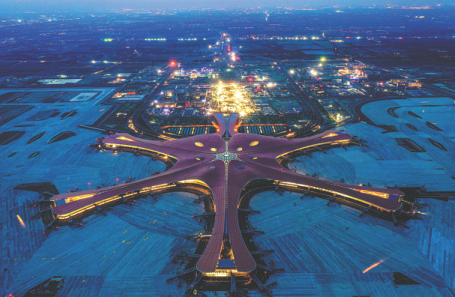New zone aims to get travelers spending more
Beijing is to build an international consumption zone based on its two aviation hubs-Beijing Capital International Airport and Beijing Daxing International Airport-according to a five-year action plan released by the municipal government earlier this month.
The plan aims to construct a consumption zone centering around the airports and their respective economic zones by 2025, enhancing Beijing's role as an international transport center and improving the business environment.
The two airports reported a combined cargo and mail throughput of 1.58 million metric tons in 2021, up 23.3 percent year-on-year, according to government data.

Beijing Daxing International Airport has a large passenger flow, with its passenger throughput surpassing 25 million in 2021. [Photo by Li Shuxiang for China Daily]
Located in the northeast of the city, Beijing Capital International Airport is one of the busiest in the world. Its annual passenger throughput reached 100 million in 2019, ranking second worldwide.
Beijing Daxing International Airport, which became operational in 2019, has launched 256 air routes and its passenger throughput surpassed 25 million in 2021.
The two airports have great potential to boost consumption, said local officials. They added that the zone will be a driving force for Beijing to build itself into an international consumption center during the 14th Five-Year Plan (2021-25).
According to the action plan, the airports are encouraged to offer visitors more consumption opportunities by building facilities such as hotels, duty-free shops and restaurants.
The Tianzhu comprehensive bonded zone near Beijing Capital International Airport will focus on biomedicine, artworks and automobiles. Meanwhile, the Beijing Daxing International Airport bonded zone will promote cross-border e-commerce and digital trade.
In addition, the two airport economic zones will build large commercial complexes, which are expected to become the capital's new consumption landmarks and benefit local people.
The plan also calls for an efficient air cargo system and better international logistic services as the city has seen a growing demand for airfreight in recent years.
Airlines are encouraged to operate more cargo flights between Beijing and major cities in North America and Europe, and explore new markets participating in the Belt and Road Initiative, according to the plan.
Meanwhile, authorities should a form a coordination mechanism involving airports, airlines, freight carriers and logistics enterprises to optimize a standardized procedure of international logistics and assist the management of cross-border trade, the plan said.
To expand the influence of the consumption zone, the city will continue to improve the transport networks around the two airports, increasing their connectivity with the downtown area.
More efforts will be made to build a batch of small regional consumption centers along the "airport-downtown" belt to spur consumption and advance integrated development, according to the plan.
zhanglinwan@chinadaily.com.cn

